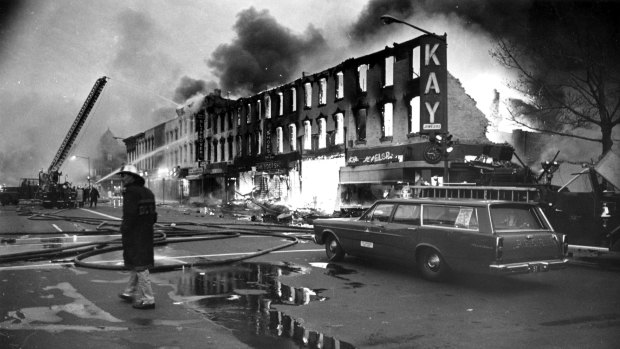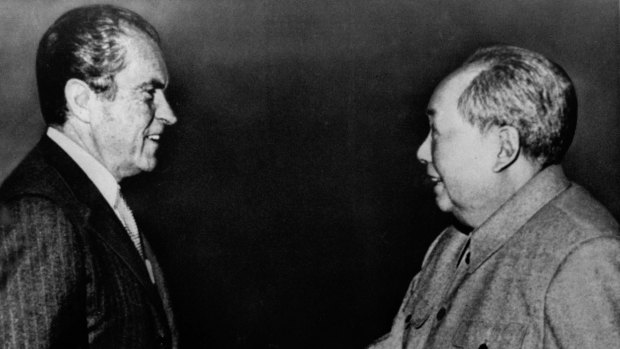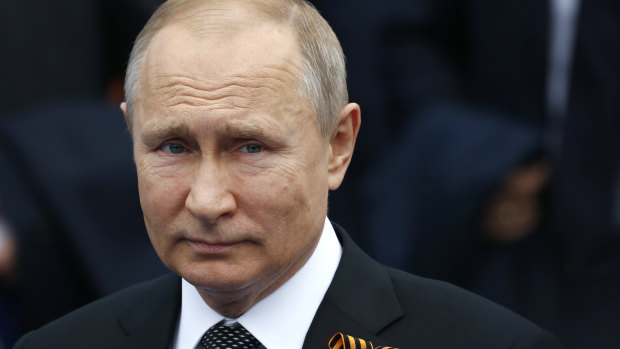This was published 5 years ago
Opinion
Reach out to Russia to manage the rise of China
Dave Sharma
Outgoing member for Wentworth and a former ambassador to IsraelSocial divisions at home and widespread public protests make for near-civil war conditions on the streets of many United States cities. The task of winding back US commitment to an unpopular expeditionary war is proving harder than imagined. The US economy is weak, buffeted by a series of external shocks.
Meanwhile, the US's principal rival for global leadership is growing seemingly stronger and more bold by the day. A president who is deeply suspicious of the establishment, and in turn resented by many of its flag-bearers, finds himself in the position of having to guide America through a retrenchment of global influence. His task is to steer the nation through a transition from dominance to leadership, and to find some sustainable equilibrium between overextension and abdication.

Nixon took power at a tumultuous time in US history. Riots had erupted following the murder of Martin Luther King.Credit: Washington Post
A golden period of almost a quarter-century, when the United States enjoyed global supremacy and was a moral exemplar to the world, seems to be drawing to a close. The parallels with today are obvious, but in fact the year is 1969.
Richard Nixon has just become president, and is seeking to end US involvement in Vietnam without a grave loss of prestige. Martin Luther King's assassination has sparked widespread race riots across the country. The Soviets have invaded Czechoslovakia. The golden post-war chapter of harmony at home and unrivalled US leadership abroad is drawing to a close.
Faced with such challenges, Nixon realised that the United States could no longer afford to "bear any burden". He declared the end of an era of US exceptionalism. Henceforth the United States would take a more limited and sustainable view of its global responsibilities, tied more closely to its national interests.
In a play that would be familiar to fans of The Last Dance, Nixon sought to manage this transition by creating a triangle: he pursued an opening with communist China, and so sought to transform a two-power world into a strategic triangle.

Richard Nixon meeting chairman Mao Zedong in 1972.Credit: AP
The strategy went against a strong strain of idealism in US foreign policy. Rather than waiting for an internal transformation in China’s governance, Nixon accepted the legitimacy of communist rule in China.
China was receptive, notwithstanding its deep hostility to the United States, because it saw the Soviet Union as at least an equal threat.
The audacious opening with China became the key to the Nixon Administration's successful Soviet strategy.
China was brought in from the cold. With China’s position now having to figure in Soviet calculations, Soviet behaviour was moderated. The United States positioned itself at the powerful apex of the triangle.
As recounted by Henry Kissinger in Diplomacy: "In a period that was, in other respects, a high point of Soviet self-confidence and a low point of America's, the Nixon Administration managed to reshuffle the deck."
The challenges of today's world are analogous. The era of unrivalled US global supremacy following the end of the Cold War is at an end. Internal challenges and divisions are draining energy, and the US public is simply no longer prepared to solely underwrite the global order.
The main US rival for global leadership today, China, has the confidence of the Soviet Union of old. Notwithstanding some internal weaknesses, China's leadership sees the future belonging to it, and the United States as yesterday's power.
China is consolidating in its periphery, growing more confident in its diplomacy, and increasingly ambitious for its role in the world.
The US-China contest, only in its early days, is already proving to be a negative-sum game. To manage the rise of China, it is time to rehabilitate the strategic triangle and reshuffle the deck. This time, the actor which needs to be brought in from the cold is Russia.

Vladimir Putin's Russia faces significant internal challenges.Credit: AP
Russia, while still a global power, is today driven by insecurity, not ambition. Its internal challenges are significant. It has reason to fear a more powerful China on its borders at least as much as it fears the West.
Russia has undoubtedly been a force for global disorder in recent years. But in the long term it is an ambitious and revanchist China, not a nostalgic Russia, which poses the larger threat to the global order.
To effect such a triangle would require a bold act of statecraft, lead by the United States but also involving Europe, Japan, Canada, Australia and the other Western allies.
In fact, the very grouping that is needed is the configuration President Trump has suggested in recent weeks: a G9 involving an expanded G7 plus Russia and Australia.
The legacy of two decades of mistrust between Russia and the West would not be easy to overcome. And indeed the cool reception from other G7 leaders to Trump's proposal shows the depth of this feeling. But the interests of each side should provide a strong basis for doing so.
We would need to provide reassurances to Russia that we would not seek to interfere in its internal political model, and would better respect its strategic anxieties.
In turn we would require that Russia cease interference in our own political systems, and end its attempts at strategic destabilisation of the West.
The triangle thus constructed would provide Russia the strategic reassurance and legitimacy it craves. It would give the United States and its allies greater diplomatic and strategic options. And – just as it did for the Soviets – it will encourage the behaviour of China to moderate.
The statecraft required is not easy, and the realpolitik underpinning it might be hard to stomach. But the geopolitical challenge of our times requires new thinking and fresh approaches.
The unipolar moment of the United States is at an end. A "G2" world has proven elusive. It is time to construct a new order based on a sustainable balance of power.